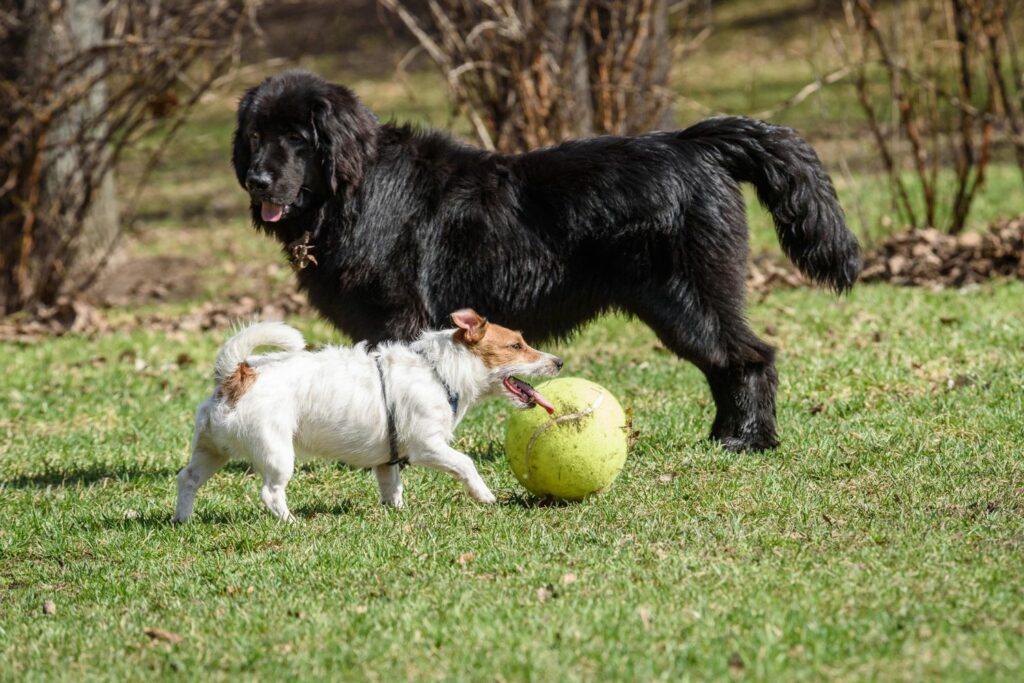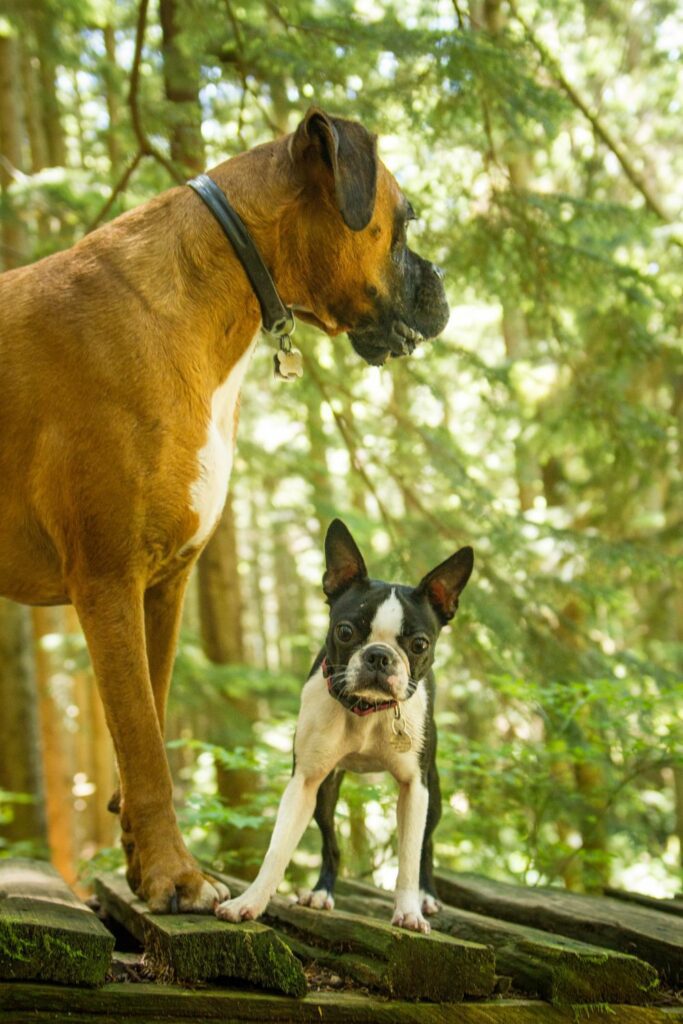Large Breed vs. Small Breed Dog Food
 Cecilie Hemsen Berg
Cecilie Hemsen Berg
Does size really matter when it comes to your dog’s diet? Absolutely! While a dog’s love and loyalty are universal no matter their size, their nutritional needs are not. Feeding your dog a diet specifically designed for them—whether it’s large breed vs. small breed dog food—is essential for supporting their health, energy, and overall well-being. But what exactly makes the dietary needs of small breeds so different from those of medium or large breeds? Let’s dive into the science behind their unique nutritional requirements and why size-specific feeding matters.
Why Breed Size Affects Nutritional Needs
Dogs can vary in size between roughly 2 and 90 kg, and this will have an impact on what diet they need. Most of us are familiar with the need for lifestyle nutrition, ie a diet that supports health and prevents disease. We also know that our puppy needs puppy food, our adult dog needs food for adults and our senior companion will do well on food tailored for the golden years. The size of your dog—whether they’re a pint-sized Pomeranian or a giant Great Dane—also directly influences their dietary requirements. Here’s why:

1. Metabolism Matters
Small-breed dogs have faster metabolisms than their larger counterparts, needing an impressive 2-3 times more calories per kilogram. This means they burn calories at a higher rate and need calorie-dense meals to keep their energy levels stable throughout the day. On the other hand, large-breed dogs have slower metabolisms, requiring fewer calories per pound of body weight to maintain a healthy balance.
2. Growth and Development
Large-breed puppies grow slower but achieve much larger final sizes. This extended growth period requires careful attention to calcium, phosphorus, and protein intake to support healthy bone development and avoid skeletal disorders like hip dysplasia (also important to avoid longer walks before the puppy is old enough). Small breeds grow quickly, so their diet needs to be packed with nutrients to support rapid development without overloading their tiny bodies. This is why you would keep large breeds on puppy food for longer than small breeds.
3. Body Composition
Smaller dogs have less fat storage and are more prone to hypoglycemia (low blood sugar) if they miss meals or don’t get enough calories. Large breeds, however, are more susceptible to obesity, joint issues, and strain on their heart if their diet isn’t properly managed.
Small-Breed vs. Large-Breed Nutritional Needs
Understanding the distinct dietary needs of small and large dogs is essential to keeping them healthy, happy, and thriving. Let’s break down what makes their nutrition unique and how you can cater to their specific requirements.

Small Dogs: Tiny Tummies, Big Energy Needs
Small breed dogs are bundles of energy with fast metabolisms, meaning they burn calories more quickly than their larger counterparts. However, their tiny stomachs can only hold so much food, so their diet needs to pack a powerful nutritional punch.
Another interesting fact is that small dogs have a longer lifespan than larger dogs, which differs from what is observed in other mammalian species.
- Energy Density: Small dogs eat smaller portions, so their food must be calorie-dense and rich in essential nutrients like high-quality protein, fat, vitamins, and minerals. Without this, they may develop deficiencies that impact their overall health.
- Protein and Fat: These dogs are often lively and energetic, requiring easily digestible protein and fat to fuel their active lifestyles while supporting muscle health.
- Kibble Size: Small breeds have smaller mouths and teeth, making appropriately sized kibble crucial for easy chewing and digestion. Oversized kibble can lead to choking or digestive issues.
- Calcium and Phosphorus: These nutrients play a significant role in maintaining dental health, as small breeds are prone to tartar and plaque buildup. A balanced diet can help keep their teeth strong and healthy. Diet, however, does not replace the need for regular brushing.
Large Dogs: Balanced Nutrition for Steady Growth
Large breeds may grow more slowly than their smaller cousins, but their nutritional needs are no less critical. Their diets must focus on controlled growth, joint health, and weight management to prevent long-term health issues.

- Calcium to Phosphorus Ratio: This balance is particularly important for large-breed puppies to ensure proper bone development and avoid skeletal issues like hip dysplasia, a common problem for larger dogs.
- Joint Support: Ingredients such as omega-3, glucosamine, chondroitin and collagen help protect joints and maintain mobility, as larger dogs place more stress on their joints. Balanced levels of vitamin D and DHA omega-3 also support joint health and reduce inflammation. These can be included in their food or provided as supplements. Nala Health contains vitamin D, Omega-3 and black soldier fly larvae which naturally contain glucosamine.
- Controlled Calories: Large breeds are prone to obesity, which can lead to joint strain, heart issues, and other complications. Their diets should focus on maintaining a healthy weight without overloading on calories.
- Protein and Fat: While protein is vital for maintaining muscle mass, large-breed diets typically feature moderate fat levels to prevent excessive weight gain while providing enough energy.
By tailoring their diets to meet these specific needs, you can help your dog live a healthier and more comfortable life—whether they’re a tiny powerhouse or a gentle giant.
Why You Shouldn’t Mix Small-Breed and Large-Breed Diets
Dog food recipes are carefully formulated to meet the nutritional needs of dogs based on their size, age or life stage, ideal weight, and activity level. A feeding schedule provides a helpful guideline to ensure your dog receives the correct daily amount of food, delivering the essential nutrients they need to stay healthy and thrive. Feeding your small dog food designed for medium to large breeds, or vice versa, can have unintended consequences:
- Undernutrition or Overnutrition: Large breed diets often have lower fat levels to prevent obesity, which may not meet the high energy needs of a small dog. Similarly, small-breed diets are more energy-dense and may contribute to weight issues in large dogs. Conversely, a large dog eating small-breed food may consume too many calories, resulting in weight gain. Small breeds fed a large-breed diet may also develop hypoglycemia.

- Imbalanced Nutrients: The feeding guide is carefully calculated based on your dog’s ideal weight and activity level to ensure they receive the right balance of protein, fat, vitamins, and minerals. Small dogs may not consume enough of a large breed diet to meet their energy needs, leading to deficiencies. Providing the wrong diet can lead to nutritional imbalances, which may impact your dog’s overall health. This is especially crucial for fat-soluble vitamins, which must be given in the correct amounts to avoid deficiencies or excesses.
- Physical Challenges: Kibble size designed for small dogs may not satisfy the chewing needs of large breeds, while larger kibble may be difficult for small breeds to eat comfortably.
Nala Health: Tailored Nutrition for Small and Large Breeds
At Nala Health, we understand the unique needs of different dog breeds. That’s why our formulas are carefully crafted to provide the right balance of nutrients for dogs of all sizes:
Adult Medium to Large Breed Formula:
- 25% protein, 12% fat, 3400 kcal/kg
- Moderate fat levels to maintain a healthy weight.
- Balanced calcium and phosphorus ratios for strong bones and joints.
- Joint-supporting nutrients like DHA omega 3 and vitamin D.
Adult Small Breed Formula:
- 26% protein, 14% fat, 3505 kcal/kg
- High energy density to support their fast metabolism.
- Easy-to-chew kibble size.
- Premium protein from black soldier fly larvae and healthy fats for sustained energy.

By choosing a size-specific diet, you’re not just feeding your dog—you’re giving them the best chance at a long, healthy, and happy life.
Final Thoughts
Feeding your dog a diet tailored to their size isn’t just a matter of preference—it’s a necessity for their health and well-being. Whether you have a tiny terrier or a majestic Boerboel, providing the right nutrition ensures they thrive at every stage of life.
The daily intake plays a crucial role in your dog’s feeding schedule, ensuring they receive the correct amount of food for optimal health. We highly recommend using a scale instead of a measuring cup for accurate portioning. Your dog’s daily intake should be determined based on their breed/size, ideal weight, activity level, and age.
It is important to take into account whether the food is complete or supplementary, as the latter alone is not enough to meet the dog’s nutritional needs.
Want to learn more about choosing the right diet for your furry friend? Have a look at our library, we have written blogs on different topics. You can also send us an email if you have specific questions regarding your dog — we’re here to help!

